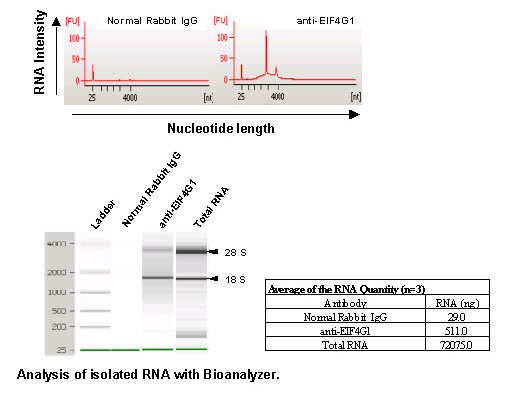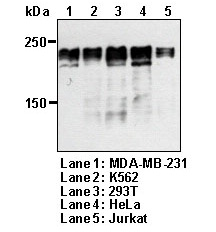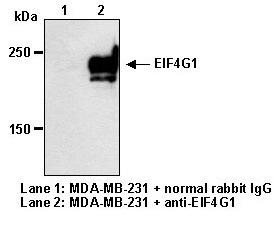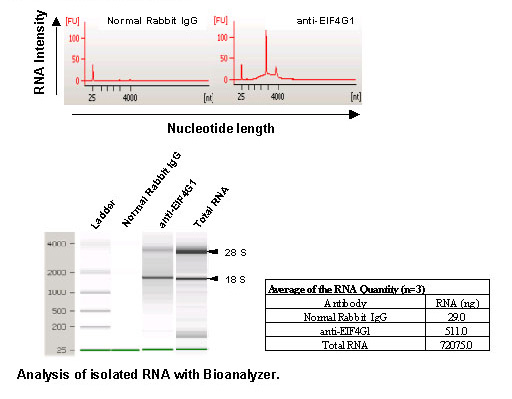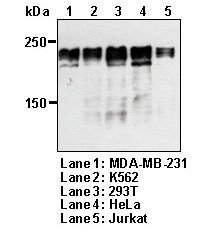Anti-EIF4G1 (Human/Mouse) pAb
| Code | Size | Price |
|---|
| MBL-RN002P | 200 ul | £404.00 |
Quantity:
Prices exclude any Taxes / VAT
Overview
Host Type: Rabbit
Antibody Clonality: Polyclonal
Regulatory Status: RUO
Target Species: Human
Applications:
- Immunoprecipitation (IP)
- RIP
- Western Blot (WB)
Shipping:
4°C
Storage:
-20°C
Images
Documents
Further Information
Applications:
WB - 1:1,000 for chemiluminescence detection system IP - 5 ug/250 uL of cell extract from
2.5 x 106 cells RIP - 15 ug/500 uL of cell extract from 4.5 x 106 cells
Background:
The eukaryote polypeptide chain initiation factor eIF4G forms complex with the mRNA cap-binding protein eIF4E and the ATP dependent RNA helicase eIF4A, constituting the initiation factor eIF4F complex. The eIF4G plays an important role in the mechanism of translation by tethering between other components of the ribosomal initiation factors. Two forms of eIF4G have been reported as two different gene products, eIF4G1 and 2. The eIF4G1 is a single polypeptide chain of 154~ kDa. The association of eIF4E with eIF4G1 results in the formation of a protease-resistant, 98-residue fragment of eIF4G1. NMR analysis study showed that this residue to be unfolded in the absence of eIF4E and almost completely folded in the presence of eIF4E. It is suggested that the eIF4E binding creates a new binding surface on eIF4G1 that allows for the binding of other factors of the translational machinery. Interaction of PABP with eIF4G1 has been suggested to facilitate the functional association of the 3' end of an mRNA with the 5' end.
Concentration:
1 mg/mL
Description:
Posttranscriptional regulation of gene expression is a ribonucleoprotein-driven process, which involves RNA binding proteins (RBPs) and non-coding RNAs that affect splicing, nuclear export, subcellular localization, mRNA decay and translation. The RNP Immunoprecipitation-Chip (RIP-Chip), RIP-Seq and RIP-RTPCR allow the identification of multiple RNA targets of RBPs globally and within the context of a cell extract. Antibodies specific to the RNA binding protein of interest are used to co-immunoprecipitate the RNA binding protein and the associated subset of mRNAs. The mRNA content is interrogated using standard microarray or sequencing technology. RIP-Certified Antibody is validated for use in RNP Immunoprecipitation (RIP) in conjunction with the RIP-Assay kit distributed from MBLI. Its ability to immunoprecipitate mRNAs and RBPs complex was confirmed by quantitative and qualitative analysis on NanoDrop, Bioanalyzer and RT-PCR or microarray.
Formulation:
200 ul volume of PBS containing 50% glycerol, pH 7.2. No preservative is contained.
Gene IDs:
Human: 1981 Mouse: 208643
Immunogen Translated:
Peptide bond synthesis GEELLPPESTPIPANLS KLH (480-496 aa)
Reactivity:
This antibody reacts with human EIF4G1 (~175.5 kDa) on Western blotting, Immunoprecipitation and RNP Immunoprecipitation.
Shelf Life:
1 year
Source:
This antibody was purified from rabbit serum by affinity column chromatography. The rabbit was immunized with KLH conjugated synthetic peptide, GEELLPPESTPIPANLS corresponding to 480-496 aa.
Target:
EIF4G1
References
1) Gradi, A., et al., Mol. Cell Biol. 18, 334-342 (1998)
2) Tarun, Jr. S. Z., et al., PNAS 94, 9046-9051 (1997)
3) Yan, R., et al., J. Biol. Chem. 267, 23226-23231 (1992)



